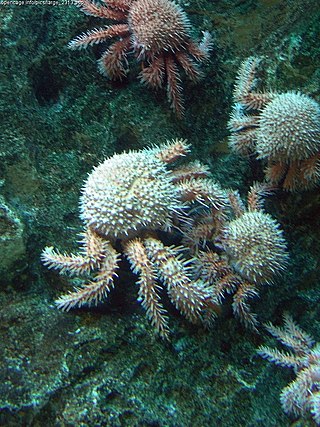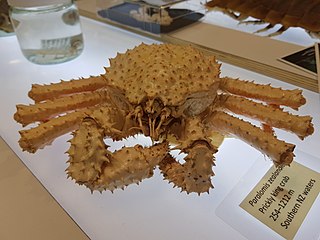In biology, nidifugous organisms are those that leave the nest shortly after hatching or birth. The term is derived from Latin nidus for "nest" and fugere, meaning "to flee". The terminology is most often used to describe birds and was introduced by Lorenz Oken in 1816. The chicks of birds in many families, such as the waterfowl, waders, and gamebirds, are usually nidifugous.

King crabs are a taxon of decapod crustaceans that are chiefly found in cold seas. Because of their large size and the taste of their meat, many species are widely caught and sold as food with the most common being the red king crab.

In biology, taxonomic rank is the relative level of a group of organisms in an ancestral or hereditary hierarchy. A common system of biological classification (taxonomy) consists of species, genus, family, order, class, phylum, kingdom, and domain. While older approaches to taxonomic classification were phenomenological, forming groups on the basis of similarities in appearance, organic structure and behaviour, methods based on genetic analysis have opened the road to cladistics.

Paralomis histrix is a species of king crab, family Lithodidae. It lives at a depth of 180–400 m (590–1,310 ft) in Tokyo Bay, Enshunada and through to Kyūshū. It has few predators because of its size and spiky carapace. It is sometimes kept in public aquariums and is occasionally referred to as the porcupine crab, a name otherwise used for Neolithodes grimaldii.
Paralomis africana is a species of king crab found off the coast of Namibia. It has been found from 570–770 metres (1,870–2,530 ft). Its carapace is pentagonal and has been measured to a width of 74.2 millimetres (2.92 in) and a length of 65.8 millimetres (2.59 in).

Paralomis is a genus of king crabs. It includes the following 69 species:
P. africana may refer to:
Raymond Brendan Manning was an American carcinologist, specialising in alpha taxonomy and mantis shrimp.

Lithodes is a genus of king crabs. Today there are about 30 recognized species, but others formerly included in this genus have been moved to Neolithodes and Paralomis. They are found in oceans around the world, ranging from shallow to deep waters, but mostly at depths of 100–1,000 m (300–3,300 ft). They are restricted to relatively cold waters, meaning that they only occur at high depths at low latitudes, but some species also shallower at high latitudes. They are medium to large crabs, and some species are or were targeted by fisheries.

Paromola cuvieri is a species of crab in the family Homolidae, the carrier crabs. It occurs in the eastern Atlantic Ocean and the Mediterranean Sea, from Angola to Norway, the Northern Isles and Iceland. It is demersal, occurring at depths of 10–1,212 metres (33–3,976 ft), but it is primarily found deeper than 80 m (260 ft). It prefers areas with mud and emerging rocks, and has been observed in deep-water coral gardens and sponge aggregations. It is locally common.

Paralomis zealandica, also known as the prickly king crab, is a species of king crab which lives at a depth of 254–1,212 m (833–3,976 ft) in New Zealand. It has spiky carapace. The scientific name of the species was first validly published in 1971 by Dawson & Yaldwyn. P. zealandica can be distinguished from other species in New Zealand waters by its thick covering of strong upright spines all over, including on its abdomen and along its legs and claws. The rostrum has three short, strong and sharp spines. It is the most prominent species of Paralomis in New Zealand.

Neolithodes agassizii is a species of king crab native to the Western Atlantic. They live at depths of 200–1,900 metres (660–6,230 ft), and have been found as far south as Rio de Janeiro, as far north as latitude 36°, and near the Equator. It has been found in the southwestern Caribbean Sea as well as the Gulf of Mexico.
Neolithodes yaldwyni is a species of king crab which is found in the Ross Sea from depths of 124–1,950 metres (407–6,398 ft). It had previously been misidentified as Neolithodes brodiei, and it closely resembles Neolithodes capensis.
Paralomis debodeorum is an extinct species of king crab which lived in New Zealand during the Middle–Late Miocene. It was discovered in the Greta Siltstone on Motunau Beach, North Canterbury, near the mouth of the Motunau River. It is a moderate-sized Paralomis and most closely resembles the extant Paralomis zealandica.
Neolithodes asperrimus is a species of king crab native to the coast of Africa. It has been found in South Africa and Mauritania at depths of 997–1,862 metres (3,271–6,109 ft), and Neolithodes aff. asperrimus has been found in Madagascar, Réunion, and the South Region of Brazil.
Neolithodes capensis is a species of king crab which is found in the Southern Ocean and the western Indian Ocean. It has been found to a depth of 660–3,200 metres (2,170–10,500 ft).
Paralomis dawsoni is a species of king crab which lives in New Caledonia, New Zealand, and the Solomon Islands at depths of 400–1,118 m (1,312–3,668 ft). It is the largest species of Paralomis in New Zealand.

Paralomis aculaeta is a species of king crab known only by the male holotype found off the coast of Prince Edward Island, a sub-Antarctic island, by J.R. Henderson on HMS Challenger in 1888. Its carapace was first described as having a width of 39 mm and length of 42 mm. It is distributed in the western outreach of the Southwest Indian Ridge. The crab is caught during bottom trawling for Lepidonotothen squamifrons, at a frequency of 25–30%.
Paralomis okitoriensis is a species of king crab.









